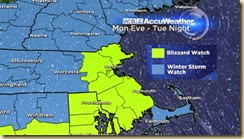 The uptick in public interest in the weather would seem to focus attention on the potential impacts of climate change – if you think outlandishly big storms are a symptom of it, that is – but what remains of primary importance is that people keep the heat and lights on.
The uptick in public interest in the weather would seem to focus attention on the potential impacts of climate change – if you think outlandishly big storms are a symptom of it, that is – but what remains of primary importance is that people keep the heat and lights on.
Obviously, the big Nor’easter now bearing down on New York, Boston and all the way to Philadelphia is the news of the day, so we thought we’d check in on the 24 reactors that cover the region. The news is good – 23 are operating at 100 percent capacity and the 24th is at 88 percent. Let’s let the coal and natural gas folks tout their own capacity factor, but I’ll wager this tops them by a margin. Bragging rights doesn’t trump the need for people to keep safe, of course, but a reliable system of power generators enhances that effort considerably.
We’ll check in tomorrow and see how things are going as
(and if) the storm really wallops the region.
---
Tropical storms and hurricanes are named by the World Meteorological Organization because “appending names to storms makes it easier for the media to report on tropical cyclones, heightens interest in warnings and increases community preparedness.” Winter storms are named by the Weather Channel if there is a commercial value to the Weather Channel:
The process of evaluating the potential to name a storm is a continual process that includes a daily hemispheric map briefing among the Global Forecast Center’s team of meteorologists at The Weather Channel.
During the map briefing, candidate weather systems are identified as potential winter storms up to a week out. As the certainty for an impactful storm increases, a storm naming committee schedules a conference call to discuss the potential named storm.
In other words, not every winter storm is named, just the ones that are likely to fill considerable air time. That makes its use patchy at best. Perhaps the Weather Channel can consider having the WMO do this naming if it can be determined that the value is the same as for tropical storms – there’s certainly an argument for it.
---
From the annals of science:
Researchers lament the fact that the U.S. hasn't articulated a date for when it hopes to have fusion go online, while China and South Korea have set timetables to put fusion online in the 2040s.
This is from a story about the state of fusion in the Huffington Post. It’s interesting in itself, but this bit stuck out. if researchers really think setting a date certain for the launch of fusion is a desirable thing, they haven’t been involved in the world of fusion for very long. We’ll check back in 2040 and see how China is doing.
Comments